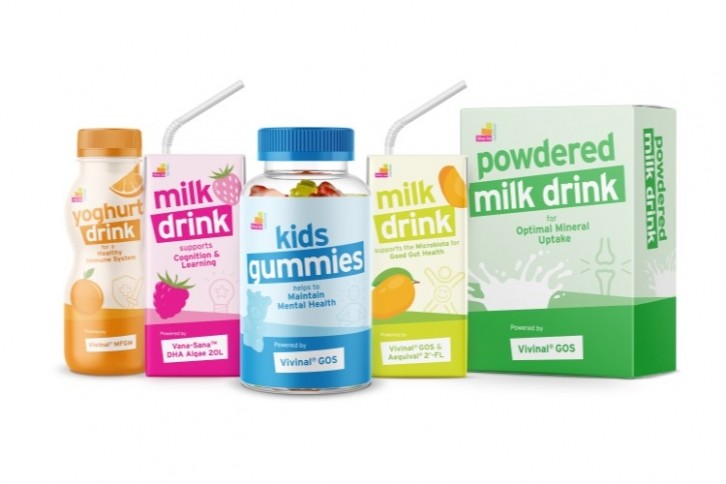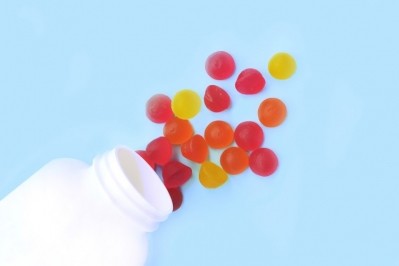FrieslandCampina Ingredients eyes ‘pockets of growth’ with new child nutrition portfolio

The ingredients that form part of the newly-unveiled Step Up Nutrition portfolio address five key areas of child development - growth, immunity, cognitive development, mental health, and gut health.
During Vitafoods Asia 2023, the company presented product prototypes fortified with a range of its ingredients for early life nutrition. These included growth-supporting powdered milk drink enriched with galacto-oligosaccharides (GOS); an immunity-boosting drinkable yogurt fortified with a milk fat globule membrane-containing ingredient; milk drinks designed to support cognition and gut health; and GOS-fortified gummies for better mental health.
A combination of ingredients is also possible, as demonstrated with the gut health-boosting milk drink which combines the company’s GOS and 2′-fucosyllactose ingredients, both non-digestible oligosaccharides to stimulate the growth of Bifidobacteria in the gut. “When combined, GOS and 2’-FL may result in complementary benefits as, together, they increase the volume and diversity of oligosaccharide structures in the gut. In their own right, GOS are beneficial to micro-nutrient absorption and may support mental health via the gut-brain axis,” said the company. Similarly, the milk drink fortified with the firm’s microencapsulated LCPUFA-containing oil provides DHA, an omega-3 fatty acid that supports cognitive function.
Seeking ‘pockets of growth’
FrieslandCampina Ingredients’ new portfolio launch comes at a time when the regular infant milk formula market is contracting. At the same time, the company claims there is a growing consumer focus on nutritional products for young children globally, a trend that can provide ‘new pockets of growth’ for the early life nutrition industry.
“The key factor is that the major product categories targeted at children this age are all on the rise, including powdered milk drinks, ready to drink and spoonable dairy, and supplements,” Timo Faber, global marketing lead for early life nutrition at FrieslandCampina Ingredients, told us.
“In fact, Euromonitor is observing double-digit annual growth in these categories in some of the world’s biggest markets, and their sales are projected to reach $34bn by 2030.”
“Secondly, with fortification now going beyond minerals and vitamins, brand owners and manufacturers are already recognizing that being in this market is the best way to differentiate their products and add value for consumers.”
Faber told us that dairy remains ‘a nutritional go-to’ for the majority of young children despite a growth in plant-based diets. “What’s more, in many countries, including China, dairy consumption continues to grow both in children and the overall population.”
However, consumption trends in different regions spell out different application possibilities for manufacturers – and dairy ingredients are well-suited for a range of applications, he explained. Asked how consumer trends differ regionally when it comes to fortified dairy products targeted at children, he explained: “The size and growth of the plant-based market is probably the biggest differentiator of Europe and, indeed, the USA, from Asia. But there’s quite a lot of commonality in terms of applications between Europe and North America, although yogurts, both spoonable and pouches, are more popular in the US than other regions.”
“Dairy products are, of course, an important base for many healthy ingredients – but ultimately, a dairy-based ingredient can go into a non-dairy product just as much as a dairy one, as we show with our gummies containing GOS.” – Timo Faber, FrieslandCampina Ingredients
He hinted that fortified gummies could be a suitable product niche for dairy brands to tap into. According to Innova Market Insights, the fortified gummy category experienced a CAGR of 37% between 2018 and 2022; North America is a market leader, though the European market is growing, with 24% of new product launches taking place there in 2022 compared to just 13% in 2021. Innova projects the global market to grow at a CAGR of 14.5% to 2028 and reach a valuation of $48.5bn.
“When I was in Bangkok last week, I spotted some probiotic yogurt-flavoured gummies in a supermarket, which was quite a new discovery for me,” Faber shared. “Creativity like this means there’s plenty of scope for growth and differentiation.”
But manufacturers planning to explore this product segment may need to address persistent consumer concerns, such as sugar content, artificial additives and colorants and divergence in nutritional value. Faber played down these concerns: “Historically of course, the issues with gummies have been their sugar, gelatine and/or artificial additive content. But these have all been successfully tackled in recent years by numerous ingredients providers and their customers. Gummies that are vegan, sugar-free and clean-label are already on the market.”
With a format that ‘already looks and feels like a bit of a treat’, adding ingredients such as GOS can bring both health benefits and additional sweetness to the taste profile, he argued, adding: “DHA-enriched gummies are already available for adults, so why not children, too?”
A 2013 systematic research of literature that aimed to evaluate existing research on the relationship of DHA with measures of learning and behavior in school-age children found that studies of brain activity had reported benefits of DHA supplementation and more than half of the studies examined reported a favorable role for DHA or long-chain omega-3 fatty acids in at least one area of cognition behaviour; studies also suggested DHA had an important role in school performance1.
Infant formula market still ‘huge’
Asked if we are likely to see more industry players pivot away from traditional early life nutrition applications, Faber told us that this is already happening. He suggested that the contraction of the infant formula market and the increased scrutiny from regulators are behind this market reshuffle. “This is the reason why manufacturers – of infant milk formula and ingredients that go into it - are focusing on this new category.
“Ultimately, this market is driven by demographics, and we don’t foresee any increase in the world’s birth rate any time soon. There is still a huge infant milk formula market, but the potential for the future lies beyond that.”
In January 2023, the Chinese national statistics bureau revealed a decline in the number of newborns for a sixth year in a row; around 9.6 million new babies were recorded in 2022, almost half of that if 2016. Meanwhile, the US market has also been under pressure since 2022, when bacterial outbreaks linked to baby powder halted production in Abbott Nutrition’s facility, triggering a wave of infant formula shortages in the US. As a result, the Food and Drug Administration has tightened its oversight of infant formula manufacturers.
Source:
The Relationship of Docosahexaenoic Acid (DHA) with Learning and Behavior in Healthy Children: A Review
Authors: Kuratko, N. C., et al
Published: Nutrients, July 2013
DOI: 10.3390/nu5072777






